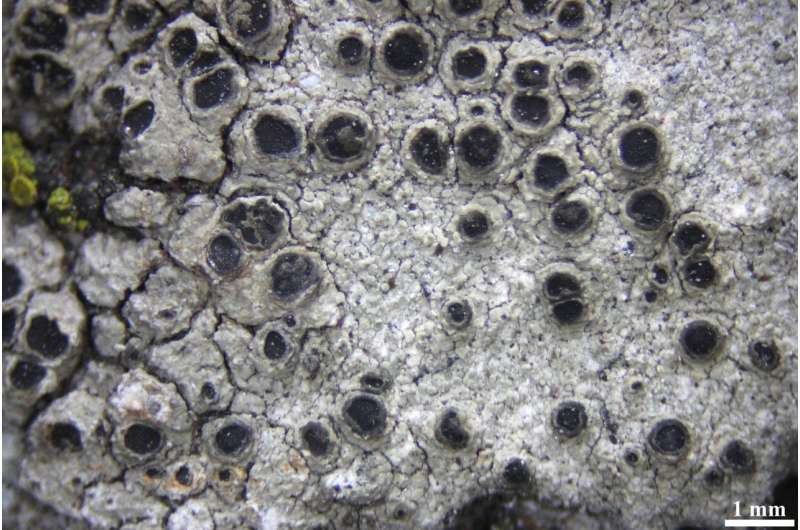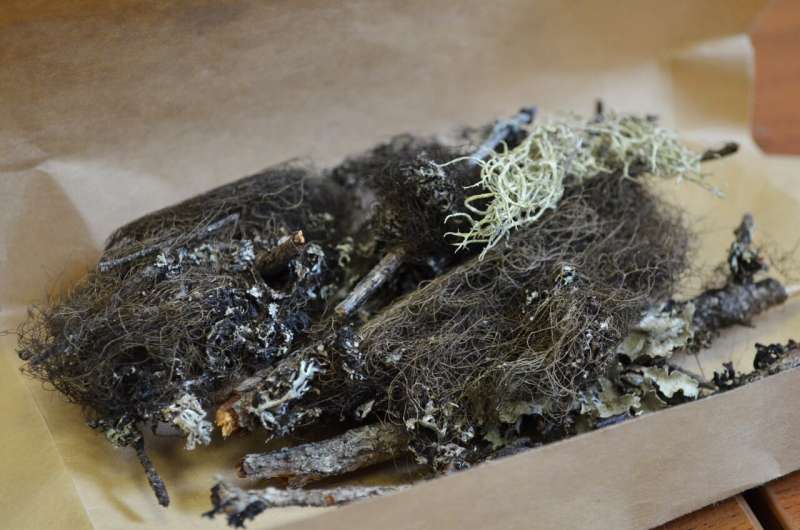Examining how lichens defend themselves against toxic metals and high acidity

The chemical composition of lichens depends on the basis (substrate) on which they grow. In this way lichens adapt to adverse conditions—such as a high level of acidity (low pH) or the presence of toxic metals. A new property of these organisms was discovered by biologists of the Ural Federal University (UrFU), who studied more than 740 species of lichens. Samples were collected from rocks and trees (spruce, pine, birch, alder, aspen, poplar). The research results was published in Frontiers in Forest and Global Change.
As Ural Federal University biologists explain, lichens growing on substrates with different chemical properties have a different spectrum of secondary metabolites. Secondary metabolites are a kind of "biochemical tool" with which the lichen defends and survives under stressful conditions. Both animals and plants have primary metabolites, while only plants have secondary metabolites. In order to find protection, animals run away, and plants produce a certain set of secondary metabolites that endow them with protective properties (taste, smell, color) and allow them to survive drought, high temperatures, the spread of infections, etc.
In lichens, secondary metabolites accumulate in large quantities. They do not participate in metabolic processes, so the role of many metabolites in the life of lichens is not clear. Scientists around the world are just beginning to study the patterns of their formation.
"Lichens contain 800-1,050 secondary metabolites or 'lichen acids,' including phenolic compounds, steroids, terpenoids, etc. Thus, some secondary metabolites give lichens a higher resistance to acidity. Others endow lichens with resistance to high concentrations of heavy metals in the substrate. At the same time, some have antimicrobial properties, which also help in survival, especially for slow-growing lichens. Lichen acids are also potential medicines for humans, possessing antitumor, anti-inflammatory, and many other properties," explains co-author, associate professor at the Department of biodiversity and bioecology at UrFU Aleksandr Paukov.

As a result of the study, it turned out that lichens adapt to a high concentration of toxic metals. Willow lichens have a relatively poor secondary chemistry, as willow bark contains a lot of salicylic acid (the tree uses this acid to protect against bacteria).
In total, the studied species contained 76 metabolites, biologists from UrFU reported. The most common among all metabolites was atranorine. For humans, this substance has anti-inflammatory, antibacterial, antifungal, cytotoxic, antioxidant, antiviral and immunomodulatory properties. Lichen, on the other hand, uses atranorine as a light filter, protecting itself from excess solar radiation.
"We also found specimens that are 'lazy' and do not produce secondary metabolites. For example, lichens on aspen produce few secondary metabolites, because the aspen bark provides them with normal vital functions. We also discovered an interesting fact—lichens have substances that they do not use in any way. We have yet to find out what they are produced for," says Aleksandr Paukov.
The next stage of research is to test the results in the laboratory. It is planned to "clean" the lichens from secondary metabolites, place them in appropriate conditions, and see if they will build up their protective properties again.
More information: Alexander Paukov et al, The Role of Secondary Metabolites and Bark Chemistry in Shaping Diversity and Abundance of Epiphytic Lichens, Frontiers in Forests and Global Change (2022).
Provided by Ural Federal University




















